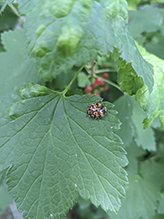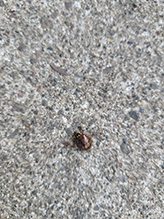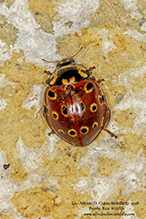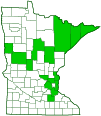eye-spotted lady beetle
(Anatis mali)
Conservation • Description • Habitat • Ecology • Distribution • Taxonomy
|
|
||||||||||||||
Description |
Eye-spotted lady beetle is a large “giant lady beetle.” It occurs across North America in the northern United States and southern Canada. The body is almost round, very convex, ¼″ to ⅜″ (7.3 to 10 mm) long, and 3 ⁄16″ to 5 ⁄16″ (5.5 to 7.6 mm) wide. The head is shallowly inserted into the thorax, but is visible from above. It is black except for two white spots between the eyes. The upper thoracic plate (pronotum) is convex and wider than long. It is white with a large black spot in the center and a small black spot on each lateral margin. The central black spot has two white spots at the base and looks vaguely like a W or M, depending on if it is viewed from the front (W) or from behind (M). The thick, hardened, shell-like forewings (elytra) are strongly convex and very narrowly flattened at the margins. They completely cover the abdomen. The background color is variable but the pattern is not. They may be yellowish-orange, reddish-orange, or dark brownish-red, but they always have fifteen black spots. Each elytron has eight spots in a 2-3-3 pattern. The spot in the middle at the base merges with one on the opposite elytron and is counted as a single spot, giving a total count of fifteen. The spots are always ringed with yellow. As the beetle ages, the elytra become darker. Older individuals are very dark reddish-brown, making the spot pattern difficult to see. The legs are yellowish-brown. The fourth segment (tibia) on the middle and hind legs have two spurs at the tip. The last part of each leg (tarsus), corresponding to the foot, has four segments, but the third segment is very short and tucked within the extended lobes of the second segment, making the leg appear to have only three segments. The tip of the last tarsal segment on the middle and hind legs has a pair of claws. Each claw has a large tooth at the base. |
Size |
Total length: ¼″ to ⅜″ (7.3 to 10 mm) |
Similar Species |
Habitat |
Forests and woodlands |
Ecology |
Season |
|
Behavior |
|
Life Cycle |
|
Larva Food |
|
Adult Food |
Aphids on trees |
Distribution |
||
|
Sources |
|
| 7/23/2024 | ||
Occurrence |
||
|
||
Taxonomy |
|
Order |
Coleoptera (Beetles) |
Suborder |
Polyphaga (Water, Rove, Scarab, Long-horned, Leaf, and Snout Beetles) |
Infraorder |
Cucujiformia |
Superfamily |
Coccinelloidea (lady, fungus, scavenger, and bark beetles) |
Family |
|
Subfamily |
Coccinellinae (common lady beetles) |
Tribe |
Coccinellini (black-spotted lady beetles) |
Genus |
|
Subordinate Taxa |
|
|
|
Synonyms |
|
Anatis borealis |
|
Common Names |
|
American eyespot ladybug eye-spotted lady beetle |
|
Glossary
Elytra
The hardened or leathery forewings of beetles used to protect the fragile hindwings, which are used for flying. Singular: elytron.
Pronotum
The exoskeletal plate on the upper side of the first segment of the thorax of an insect.
Tarsus
On insects, the last two to five subdivisions of the leg, attached to the tibia; the foot. On spiders, the last segment of the leg. Plural: tarsi.
Tibia
The fourth segment of an insect leg, after the femur and before the tarsus (foot). The fifth segment of a spider leg or palp. Plural: tibiae.
Visitor Photos |
||
Share your photo of this insect. |
||
This button not working for you? |
||
Tyler |
||
 |
|
|
I can't believe one of these just came to rest on our sliding door glass |
|
|
Kristin Bahner |
||
Eye spotted Lady Beetle I found an eye spotted Lady Beetle today in Maple Grove MN. I am not sure it is marked on your map but I appreciate the site and its information. |
 |
|
Karyn |
||
 |
||
Trista C. |
||
 |
||
Alfredo Colon |
||
 |
||
MinnesotaSeasons.com Photos |
||
|
||
|
||

Slideshows |
|

Visitor Videos |
||
Share your video of this insect. |
||
This button not working for you? |
||
|
Other Videos |
||
The Eye-Spotted Lady Beetle |
About
Published on Oct 24, 2012 Anatis mali, brown Identification: Range: Ontario to British Columbia, south to Virginia and Oregon. |

Visitor Sightings |
||
Report a sighting of this insect. |
||
This button not working for you? |
||
Tyler |
Location: Itasca County I can't believe one of these just came to rest on our sliding door glass |
 |
| Ken Jarratt 9/8/2023 |
Location: Maidenhead. BERKSHIRE. ENGLAND. I'm sure these are rare in England. I have never seen one before. |
|
| Kristin Bahner 9/28/2022 |
Location: Maple Grove MN I found an eye spotted Lady Beetle today in Maple Grove MN. I am not sure it is marked on your map but I appreciate the site and its information. |
 |
| Karyn 7/6/2022 |
Location: West St. Paul, MN |
 |
| Trista C. 6/17/2022 |
Location: Zimmerman, MN (Sherburne Co.) |
 |
| Alfredo Colon 8/20/2018 |
Location: Woodbury, Minnesota |
 |
MinnesotaSeasons.com Sightings |
||
|

Created: 6/11/2019 Last Updated: © MinnesotaSeasons.com. All rights reserved. |
